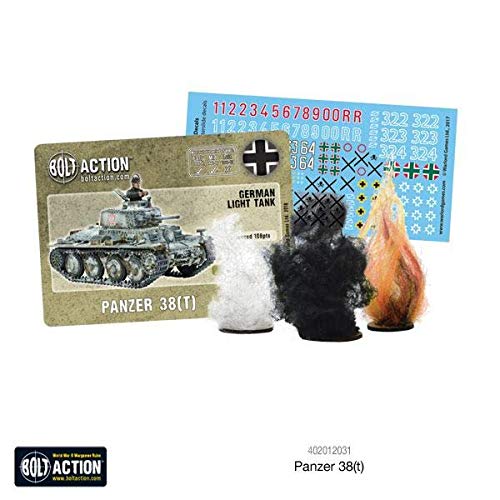Warlord Games
Bolt Action - Germany: Blitzkrieg German Infantry and Panzer 38(T) Set
Couldn't load pickup availability

Representing the classic image of the German infantryman during World War II, these miniatures are equipped with knee-high jackboots, unadorned 'coalscuttle' helmet and a martial discipline that took them to almost complete dominance of mainland Europe.
Whilst the glory often went to the armoured knights of the panzer divisions, the infantry were the spine of the Wehrmacht. Germany's cunning use of Blitzkrieg tactics conquered Poland, swept through the Low Countries and defeated France, before turning their attention to the Soviet Union. Soviet forces were pushed all the way to Moscow as the relentless march of Hitler's landsers swept all before them.
Well-led, superbly trained and equipped with the finest infantry weapons in the world, the German infantryman was a skilled and dangerous foe capable of thinking for themselves if needed, giving them a significant advantage over their foes. Vorwarts!
Blitzkrieg German Infantry contains:
- Enough plastic components to make 30 German infantry miniatures - Including a host of options to allow for different weapon configurations and command models.
- Weapons included: Kar 98K rifle, MP38/MP40 sub-machine gun, Luger pistol, MG34 light machine gun, Kar 98K with attached bayonet, stick grenades, scoped Kar 98K rifle.
- Round plastic bases (25mm diameter).
- Construction leaflet.
Most commonly known as the Panzer 38(t), this light tank was originally a Czech design – the LT vz. 38 – which fell under the Third Reich's control when Germany occupied Czechoslovakia in 1938. The 't' in its designation relates to the German for Czech – tschechisch.
This box set contains:
- One hard plastic Panzer 38(t)
- A quick reference Bolt Action Stat card
- A set of damage markers
- A Full-coloured waterslide decal sheet
- A detailed construction leaflet
Well-liked by its crews for its dependability and ease of repair, over 1,400 38(t)s were produced and saw active service for Germany during the invasion of Poland, the Battle for France and on the Eastern Front.
Its light weight made it ideal for use as a fast attack or reconnaissance vehicle. With its armament being considered too light against the increasingly heavier enemy vehicles, manufacture of the 38(t) ceased in 1942. It would continue to serve for the rest of the war both with German and Hungarian, Romanian and Bulgarian militaries (the waterslide decal sheet included allows for variants of each of these nations to be built).
The reliable 38(t) would continue to serve the Wehrmacht well by providing the basis for several highly successful variants such as the Hetzer and Marder tank destroyers, as well as flakpanzers.
Models supplied unassembled and unpainted
Share










